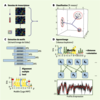Prédire la transcription à partir des séquences génomique
Résumé
Les développements technologiques récentsont grandement facilité et accéléré l’obtentiondes séquences nucléiques à l’échelle génomique.À partir de ces séquences, les bio-informaticienstentent de délimiter les régions fonctionnelles,y compris bien sûr les gènes, maisaussi les motifs et les conditions qui contrôlentleur expression. Dans un article récemmentpublié dans Cell, M.A. Beer et S. Tavazoie combinentune méthode de classification (clustering)de données de transcriptome (puces àADN), un logiciel de découverte de motifs cisrégulateurs,ainsi qu’une méthode d’apprentissageprobabiliste pour inférer des règles susceptiblesde rendre compte des profils d’expressiontranscriptionnelle observés. Technological developments have enhanced DNA sequencing atgenomic scale. On the basis of the resulting sequences, computationalbiologists now attempt to localise the most importantfunctional regions, starting with genes, but also importantlythe regulatory motifs and conditions controlling theirexpression. In a recent paper published in Cell, M.A. Beer and S.Tavazoie report the results obtained by combining statisticalclassifications (clustering) of transcriptome data (DNAchips), software for the discovery of cis-regulatory patterns,together with a probabilistic learning method to infer regulatoryrules tentatively accounting for the observed transcriptional profiles.
Pour citer ce document
Martin, David ; Ghattas, Badih ; Thieffry, Denis ; Prédire la transcription à partir des séquences génomique, Med Sci (Paris), 2004, Vol. 20, N° 11; p. 1036-1040 ; DOI : 10.1051/medsci/200420111036




